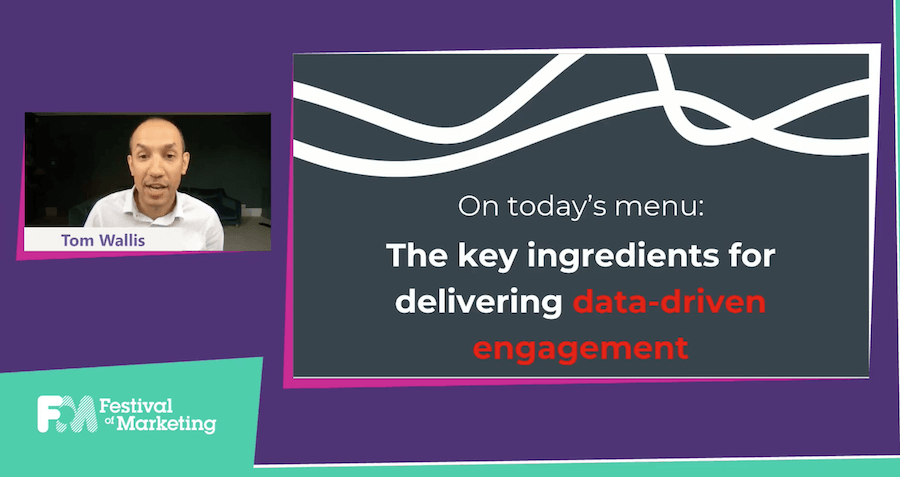Tom Wallis, CMO of Gousto, gave a talk at the Festival of Marketing 2020 today, explaining how the company uses a data-driven strategy to deliver real value to its customers.
Gousto is a recipe-box company that sends easy-to-follow recipe cards (and precise ingredients) to enable customers to cook up impressive meals at home.
Wallis breaks down what the company has learnt over the past eight years, and outlines the five key ingredients of a data-driven engagement strategy; “one that goes beyond A/B testing and growth hacking, towards empathy and insights, and a better customer experience.”
1. Have your data (house) in order
“The data you use should be trusted by the people in the company, accurate, and accessible to all,” Wallis explains. “Trusted and accurate in the sense that, everyone who uses it knows that it is reliable, so that they can be confident in acting upon the insights that it is giving them.”
Wallis also stresses the importance of making data open and accessible for everyone who needs to query it and learn from it. He says, “One of things that this has given us (and should give you) is a real feel amongst the team that they understand what customers are doing and why they are doing it.”
“It builds up a knowledge of behaviour over time that is much more than people can get from monthly presentations about customer behaviour.”
Wallis also comments on the importance of getting data into a structure that’s usable early on, which is typically harder to do once a company has grown bigger. “If you have the opportunity at the early stages of a company to think about your data structure, take the time to do that”, he states.
2. Be relevant and personalised (and personal)
“I am working from home at the moment as many of you are, and I’ve got into the habit of going to the cafe at the end of my road to pick up some lunch each day”, Wallis tells us.
“When they first opened we always shared a joke about how they didn’t have my favourite flavour of crisps (cheese and onion), but the day they did get them in, they were first to tell me.” As Wallis says, “the point of that (story) is, I actually choose to go there now versus the other options, because I enjoy it.”
Over time, Gousto has moved on from a pattern of using data to gain more sales or simply to improve conversion rates, to thinking about how the company can be truly helpful, and to create a delightful customer experience. “That equally, will translate into better results for your company.”
Wallis cites another example of buying from a company that he was previously loyal to. “They put a personalised note in the delivery, noticing that I had ordered a lot from them in the past and that they were extremely grateful to have me back”, he explains. “Those little touches are things that you can use to build a connection with your customers.”
3. Be timely
“If you have your data in order, it’s just as important to make sure that the systems and processes around it are able to take advantage of it as quickly as possible.”
Wallis describes how Gousto has gone beyond standard triggered responses (such as a follow-up message to a subscription cancellation), to more advanced type of communication. “For example, we use the types of meals that people have ordered to infer what they would like to order in future, and to present recommendations.”
“It’s important that we do that as quickly as possible for a new customer joining Gousto, so that we can be helpful early on in their journey.” He explains, “We’ve gone from taking 16 recipe suggestions – before we are able to get a picture of what they like – and using data science and machine learning to bring that down to eight or so.”
4. Be appreciated
Wallis paraphrases Jeff Goldbum in Jurassic Park to highlight his fourth point: “Just because you can do something, it doesn’t mean you should.”
By this, Wallis means that – while customers are in most cases appreciative when their data improves their experience – there are times when companies can be guilty of using it to their own advantage, and that is not necessarily the right thing to do.
“We may have once recognised that sending an SMS to customers is an effective way to defeat the problems of email open rates,” he explains. “We have the information to do that, but it’s not what customers want to see from a company.”
“Instead, using it for more appropriate communication such as ‘We’ve noticed your delivery has been delayed’ or ‘We’ve noticed an ingredient is missing from your box’ – that kind if proactive communication that’s timely and urgent when necessary is much more appreciated.”
“You want to make sure that all your use of data is something that people will value, and not something that is interruptive in an unpleasant way.”
5. Have permission (GDPR)
Finally, Wallis highlights the importance of permission, specifically on the back of GDPR regulations coming into force.
“GDPR is something that we need to work with and ultimately embrace, because it is about consent, it is about permission…” he says, “and if we are using customer’s data sensibly and effectively, customers will continue give us that permission.”
“That is why it is such an important thing to recognise, and to value.”
Digital Transformation and the Role of Data







